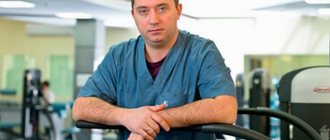What are the basic rules of a healthy lifestyle?
Basic rules for a healthy lifestyle include:
Weight loss
It is well known that obesity is a risk factor for the development of hypertension and diabetes mellitus. Most people with high blood pressure are overweight. The abdominal type of obesity (excessive fat deposition in the neck, abdomen and chest) is most typical for patients with impaired fat metabolism, diabetes mellitus, and hypertension. Therefore, the most effective way to combat hypertension is weight loss. A weight loss program includes a low-calorie, fat-restricted diet and increased physical activity (regular dynamic exercise), which promotes gradual and sustainable weight loss.
Reducing salt intake
Studies have shown that blood pressure levels are directly related to the amount of salt consumed. Most people consume more salt than necessary. To reduce blood pressure, the average dose of salt should not exceed 5 g. (1 teaspoon) per day. Reducing salt intake can reduce blood pressure by 9/6 mmHg. Elderly hypertensive patients and patients with heart or renal failure should strictly adhere to this recommendation. There are foods that initially contain large amounts of salt. These include: tomatoes, olives, soy sauce, biscuits, cheeses, pancakes, tomato juice, beans, spinach, ham, sauces, ready-made soups. Patients suffering from hypertension should exclude these foods from their diet.
Increased physical activity
Regular physical training reduces blood pressure by 5-10 mmHg. You should not engage in exhausting sports. Dynamic loads such as walking, swimming, cycling, etc. are recommended. Physical exercise should be regular, approximately 3-4 times a week for 20-30 minutes.
Increased physical activity will not only reduce your risk of developing cardiovascular disease, but will also significantly improve your well-being and mood.
To give up smoking
Nicotine has a detrimental effect on the body. Under the influence of nicotine, the heart rate increases, vascular spasm occurs, and atherosclerosis appears over time. Smoking patients are 2 times more likely to die from cardiovascular complications compared to non-smokers. In addition, smoking increases the risk of developing lung cancer, bladder cancer, and causes damage to peripheral arteries. You should stop smoking immediately. In some situations, specialist help is necessary.
Compliance with dietary recommendations
Compliance with a special diet designed for people with high blood pressure leads to a decrease in blood pressure after only 8 weeks of use. This diet includes complete foods containing mainly plant protein, microelements (magnesium, calcium, potassium), very low fat foods and plant carbohydrates. It is necessary to give preference to vegetables, fruits, low-fat dairy products, fish, and lean meat. Frequent consumption of food in small portions (4-5 times a day) is recommended. In addition, it is necessary to correctly distribute food intake throughout the day (breakfast - 20%, lunch - 40%, dinner - 10%, last meal at least 2-3 hours before bedtime).
Relaxation
Stress is the scourge of our time. Learn to deal with stress adequately. Don't try to suppress negative emotions by smoking, overeating or drinking alcohol. There are types of relaxation such as yoga, meditation, hypnosis. Using these techniques once or twice a week will reduce the levels of catecholamines, which increase blood pressure.
If, despite following all non-drug measures, you still have elevated blood pressure readings, do not be upset and continue to lead a healthy lifestyle. These measures will significantly reduce the risk of heart disease and help control blood pressure with lower doses of antihypertensive drugs.
What are the risk factors for hypertension?
Controllable risk factors include unhealthy diets (excessive salt intake, high levels of saturated fat and wasteful foods, insufficient consumption of fruits and vegetables), lack of physical activity, tobacco and alcohol use, and overweight and obesity.
Uncontrollable risk factors include a family history of hypertension, age over 65, and underlying medical conditions such as diabetes or kidney disease.
What are the typical symptoms of hypertension?
Hypertension is called the “silent killer”. Most patients with hypertension are not even aware of the problem, since hypertension often does not give warning signs and is asymptomatic. This is why it is so important to measure your blood pressure regularly.
When symptoms occur, they may include early morning headaches, nosebleeds, irregular heart rhythms, blurred vision and ringing in the ears. Severe hypertension can cause weakness, nausea, vomiting, confusion, internal tension, chest pain and muscle tremors.
The only way to detect hypertension is to have your blood pressure measured by a medical professional. Blood pressure measurement is quick and painless. Although it is possible to measure your blood pressure yourself using automatic devices, a medical professional must conduct the assessment to assess the risk and associated disorders.
Treatment of hypertension with essential oils: hypertonic compresses
Compresses with mustard are most often used for hypertension. To do this, dilute mustard in warm water, moisten a bandage or towel with the solution and apply it to the calf muscles.
Hypertonic compresses with sea salt help reduce blood pressure and improve blood circulation. The base is prepared in the same way as in the previous case. Compresses are placed on the forehead, closer to the area between the eyebrows. You need to keep the compress for 15-20 minutes. To obtain a noticeable effect, you need to do this procedure for at least a week.
Essential oils can be used for compresses, but they must first be diluted with milk or water (1 tablespoon) to avoid skin irritation. Place the compress on the forehead close to the area between the eyebrows and keep it there for no more than 20 minutes. For aromatic compresses when treating hypertension with oils, the following combinations can be used.
1. Tangerine oil (3 drops) + lemon or lime oil (2 drops) + fir oil (1 drop).
2. Geranium oil (2 drops) + lavender oil (1 drop) + cypress oil (1 drop) + lime oil (1 drop).
3. Tangerine oil (3 drops) + ylang-ylang oil (1 drop) + marjoram oil (2 drops).
For hypertension, essential oils can be combined with salt compresses.
In warm water (about 200 ml) you need to dissolve sea salt, add 2 drops each of marjoram, lavender, ylang-ylang, mandarin and geranium oils. Soak a towel or a bandage folded several times in this mixture and apply to the calves or the lower part of the back of the head.
Why is hypertension an issue in low- and middle-income countries?
The prevalence of hypertension varies across regions and countries of different income categories. Hypertension is most prevalent in the WHO African Region (27%) and lowest in the Region of the Americas (18%).
The number of adults with hypertension increased from 594 million in 1975 to 1.13 billion in 2015, primarily in low- and middle-income countries. This increase is mainly due to increased risk factors for hypertension among the populations of these countries.
What are the complications of uncontrolled hypertension?
Among other complications, hypertension can cause serious harm to the heart. Excessive pressure can cause artery walls to lose their elasticity and reduce the flow of blood and oxygen to the heart muscle. This increased blood pressure and decreased blood flow can cause:
- chest pain, also called angina;
- a heart attack that occurs when blood flow to the heart is blocked, causing heart muscle cells to die from oxygen starvation; the longer blood flow is blocked, the more serious the damage to the heart;
- heart failure, in which the pumping function of the heart muscle cannot fully supply other important organs with blood and oxygen;
- cardiac arrhythmia, which can lead to sudden death.
Hypertension can also cause stroke, causing the arteries that supply blood and oxygen to the brain to rupture or become blocked. In addition, hypertension can cause kidney failure caused by kidney damage.
How does WHO respond to the problem of hypertension?
The World Health Organization (WHO) is supporting countries to reduce the prevalence of hypertension as a public health problem.
In 2021, WHO released new guidelines for the pharmacological treatment of hypertension in adults. The publication provides evidence-based recommendations on when to begin treatment for hypertension, as well as recommended follow-up intervals for the patient. The document also identifies blood pressure targets that must be achieved to control hypertension and provides information on health care actors who can initiate treatment.
In September 2021, to help governments improve the prevention and treatment of cardiovascular disease, WHO and the United States Centers for Disease Control and Prevention (CDC) launched the Global Hearts Initiative, which developed the HEARTS technical intervention package. The six modules of the HEARTS technical package (healthy lifestyle counselling, evidence-based treatment protocols, access to essential medicines and technologies, risk-based case management, team-based care and monitoring systems) provide a strategic approach to promoting cardiovascular health. -vascular system in various countries of the world.
In September 2021, WHO launched a partnership with Vital Strategies' Resolve to Save Lives initiative to support governments in implementing the Global Hearts initiative. Other partners involved in the Global Hearts Initiative include: US CDC Foundation, Global Health Advocacy Incubator, Johns Hopkins Bloomberg School of Public Health, Pan American Health Organization (PAHO) and US CDC. Since the program began in 2021, 3 million people in 18 low- and middle-income countries have received hypertension treatment protocols through patient-centered care models. These programs provide clear evidence of the feasibility and effectiveness of standardized hypertension control programs.
Dosed walking for hypertension
Walking is recommended as physical therapy. It allows you to increase the endurance of the body, saturate it with oxygen, strengthen blood vessels and the heart.
Dosed walking for hypertension should be done on level ground and when the temperature outside is comfortable. The first walks should not exceed a distance of 1 km. Gradually, when the body gets used to the loads, the pace and distance are increased. This occurs approximately on the fifth day of the period of regular classes, and sometimes earlier. Then the distance increases to 2 km, and after another 5 days - to 3 km.
In the first days, very slow walking is recommended - if you have hypertension, you need to take no more than 60 steps per minute, then just slow (70 steps per minute), then medium (90 steps per minute) and, finally, fast (120 steps per minute).
At the second stage of hypertension, the pace should not exceed 70 steps per minute.
Breathing while walking should be through the nose. If you want to start breathing through your mouth, reduce the pace. In this case, it is necessary to measure the pulse; as a rule, it will become faster, and this indicates an excessive load on the heart. It is not recommended to fully load the heart; in any case, there should be a small “reserve”.
In addition to regular walking, in sanatoriums, at a certain stage of rehabilitation, walking on uneven terrain (terrenkur) can be prescribed as physical therapy. Usually such routes are marked within the sanatorium. In combination with the previous method - walking on level ground - this type of walking trains the heart well, improves muscle and vascular tone, and improves metabolic processes.
Healthy training is characterized by increased physical activity and is intended for patients with the initial stage of hypertension.
An easy path is limited to a distance of 0.5 km, an average one - 1.5 km, and an extreme one - 3 km. The load may increase depending on the angle of elevation, as well as the pace of walking. The maximum pace is no more than 100 steps per minute. Getting used to the health path is carried out gradually. In this case, every 200 m you need to stop and measure your pulse, note uncharacteristic changes in breathing and heart function. All loads associated with such walking are monitored by a doctor and a specialist in physical therapy.
What set of physical exercises to do for hypertension (with video)
This set of exercises for hypertension is performed in a sitting position.
1. Sit on the edge of a chair. Place your hands on your hips. Begin to bend your right leg, straightening your left leg at the same time, and then vice versa (without lifting it off the floor!). Try to breathe in and out calmly. Repeat the exercise 5 times.
2. Make a circular motion forward with your right hand and then back. Change your hand and repeat the same exercise again. Repeat this physical exercise for hypertension 5 times.
3. As you inhale, stretch your arms forward and then out to the sides. As you exhale, lower your arms. Repeat the exercise 5 times.
4. As you inhale, place your hands on the seat , and as you exhale, straighten your leg up, while leaning so that your back touches the back of the chair. Repeat the exercise with each leg 5 times in turn.
5. Relax. As you inhale, raise your arms up, then lower them, take them back and lean forward. Exhale without lowering your arms. Repeat the exercise 5 times.
6. To perform this exercise for hypertension, while inhaling, spread your arms to the sides, then use your hands to pull your knee to your chest, while exhaling. Repeat the exercise 5 times.
7. Place your hands on your waist. As you inhale, turn your head and move your right arm to the right and back; as you exhale, return your arm to its original position. Do the same with your left hand. Repeat the exercise 5 times.
8. Stand on your toes. As you inhale, stretch your arms forward, and as you exhale, lower them onto the chair.
Watch the video “Exercises for Hypertension” to better understand how the treatment complex is performed:
Treatment of hypertension with breathing: therapeutic breathing exercises
Breathing exercises for hypertension are a relatively new type of disease prevention. The main emphasis is not on the exercises themselves, but on breathing techniques. The main thing is to gradually develop a breathing rhythm.
Breathing exercises for hypertension using the method of A. N. Strelnikova, which is adopted by specialists, are especially effective, adapting it to each patient individually.
The principle of this type of gymnastics is as follows: starting with a short, noisy inhalation through the nose, you need to exhale freely without focusing on it. This technique is repeated 4 times, after some time the number of inhalations and exhalations doubles, ultimately reaching 32 breaths.
In addition to breathing exercises, short breathing relaxation is also recommended for treating hypertension at home - it helps reduce blood pressure caused by heavy mental or emotional stress. You need to lie down, relax as much as possible, and not think about your experiences.
Inhale arbitrarily and hold the exhalation for about 8 seconds. You need to perform breathing exercises for 3-4 minutes.
The method of diaphragmatic breathing, used in physical therapy, is also recommended as therapeutic breathing for hypertension. It is based on helping hypertensive patients control their respiratory rhythm. This method allows you to saturate the body with oxygen, strengthen blood vessels in the diaphragmatic area, improve blood supply to the heart, and regulate blood flow.
To treat hypertension with breathing, lie on your back, bend your knees, relax your abdominal muscles. Place your hands on your stomach to feel the air movement. Inhale through your nose and “inflate” your stomach. When exhaling through your mouth, release the air slowly (in small portions), while simultaneously “blowing out” your stomach.
Baths and wraps for hypertension
For hypertension, special baths are useful. They can be general (when the whole body is immersed in water) and local (when arms or legs are immersed in water).
General baths are divided into those that can only be taken in medical institutions, and those that can be taken at home. Baths in a clinic (sanatorium, dispensary) are taken under the supervision of a specialist. There are several types of baths that are intended for the prevention of hypertension at different stages: mineral (chloride, sodium, magnesium, calcium, bicarbonate, sulfate and their mixed types, carbon dioxide, hydrogen sulfide), nitrogen, salt (including radon), mud. The listed types of baths may not be suitable for all patients due to individual intolerance and unidentified body disorders. This may not appear immediately, so if you feel worse while taking a bath or immediately after it, you should inform your doctor.
At home, baths for hypertension with the addition of pine extract are recommended, which give a calming effect. Baths with the addition of essential oils of pine, fir, cedar, lavender, citrus fruits, and roses have a good effect on the nervous system. The water in the bath should not exceed 37 °C, since too hot water will have the opposite effect - extra stress on the blood vessels. Before adding essential oil (20 drops) to water, you need to dissolve it in 1 tablespoon of milk so that it does not irritate the skin. The bath should take no more than 10-15 minutes.
For baths, you can also use sea salt with pine needle extract.
Of the local baths, mustard is most often used - for the feet. The water temperature should not exceed 40 °C. Baths with mustard are good for reducing blood pressure. They can be used as first aid for hypertensive crisis. The duration of the bath is no more than 20 minutes.
In a hospital setting, in the initial or middle stages of hypertension, local Gauff baths can be used to improve blood circulation in the heart - for the arms and legs at the same time. It can be difficult to use them at home. Hands and feet are immersed in water heated to 37 °C and the temperature is raised to 42 °C for 15 minutes, after which the water temperature is maintained at this level for about another 15 minutes. The course of treatment with Gauffe baths is 10-15 procedures.
Baths for hands and feet differ from general baths in that they are hot, i.e. their temperature is higher. This is done so that the source of activation of blood circulation is further from the heart, while there is no excessive expansion of the cardiac arteries and no load on the heart itself. Due to peripheral vasodilation, the heart rate slows down and blood pressure decreases.
Varicose veins are a contraindication for local baths.
Another useful water treatment is using a wet wrap. A wet, wrung-out sheet is laid out on top of a flannelette or woolen blanket, the patient is placed on it and asked to stretch out his arms. Then they wrap one end of the sheet around the patient, lower their arms and cover them with the other end of the sheet. They wrap him in a sheet almost up to his shoulders and wrap him in a blanket. In this case, the temperature of the water for soaking the sheet should be about 30 ° C, and the wrapping should occur quickly so that the person does not have time to freeze and does not experience vasospasm. The procedure lasts approximately 55 minutes. For hypertensive patients with normal weight, 45 minutes is enough. Wet wrap has a great effect on the central nervous system, improves blood circulation, strengthens the heart, and normalizes metabolism.










